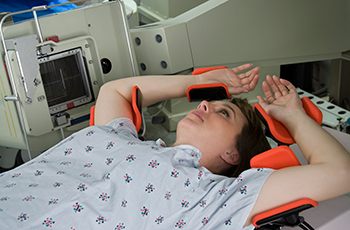Cancer Treatment
Cancer Treatment
“What Cancer Cannot Do”
Cancer is nothing more than a speed-breaker, it does not define the entire journey of life. Once you are past it, it can become a faint memory, only if you return to life more spiritedly than ever before!
Cancer management is often multimodality. Once the diagnosis is confirmed, and the tumour biology determined, investigations to rule out systemic spread are conducted before moving on to the planned management. This could involve an ultrasound abdomen, X-ray chest and/or bone scan or a CECT chest/abdomen and bone scan or a PET CT.
The sequence of treatment i.e Surgery first or Systemic treatment first will depend not only on the stage of the disease but importantly, also on the biology of the disease.

Surgery
Breast Surgery for cancer addresses two main aspects- Surgery to the breast and of the armpit or axilla. Surgery to the breast would entail either mastectomy (breast removal) or breast conservation surgery (breast preserved). Surgery of axilla would be either Sentinel Lymph Node Biopsy (SLNB) in those in whom no nodes are felt in the axilla or in those where an FNAC of the lymph node does not show evidence of disease or Axillary dissection, wherein the node in the armpit is involved by the disease.The decision on the type of surgery will vary from patient to patient and is decided on the basis of clinical findings, imaging, genetic testing, co-morbidities, availability of radiation facility etc. A detailed discussion with the patient and family to understand the pros and cons of the procedures offered, reconstructive options etc. will help arrive at a consensus.
Systemic treatment
-
- Chemotherapy
Chemotherapy uses anti-cancer drugs that may be given intravenously or by oral intake. Chemotherapy can be given before surgery (Neo-adjuvant Chemotherapy) or after surgery (Adjuvant chemotherapy) on the basis of tumour stage and biology.Despite advancements in cancer treatment, it is still not possible to omit chemotherapy in the majority of patients with breast cancer. Chemotherapy may be skipped in very few, on the basis of the tumour biology, staging and gene assays. The stigma and fear attached to chemotherapy are well known amongst cancer patients, but the benefit accruing from chemotherapy far outdoes the risks associated with chemotherapy. The side effects of chemotherapy are because chemotherapy only recognises rapidly dividing cells and targets them. As a consequence, while cancer cells are rapidly dividing, so are the hair follicles, the lining of the intestinal tract, the bone marrow etc. This is the reason for the side effects like, hair fall, nausea, vomiting, diarrhoea, infections etc that arise post-chemotherapy. The good thing is that all these side effects are temporary and recovery starts after cessation of chemotherapy. - Targeted Treatment
Targeted therapy is a treatment that uses drugs to target specific genes and proteins that are expressed by breast cancer cells and the expression of which cause the tumour cells to multiply. Targeted therapy, as the name suggests, targets those cells which express these proteins and prevent their multiplication and cause their death.Targeted therapy is administered along with chemotherapy to start with and then continued for a total period of a year. Since they attack a specific target, they don’t cause the same side effects as chemotherapy. Targeted treatment has much lesser side effects as compared to chemotherapyResearch is currently underway to find newer targeted treatments and slowly, but surely, we are moving towards an era of highly personalised and individualised treatments, with fewer side effects - Hormonal Therapy
Hormonal therapy is yet another and very important modality of treatment in breast cancer. Hormonal treatment may actually be looked upon as the earliest targeted treatment. The reason why it may be thought of as one is because it works on those tumour cells which carry the receptors for estrogen and progesterone hormone on their surface. On administering anti-estrogenic therapy or hormone therapy, it works by either attaching itself to the hormone receptor and preventing the estrogen from stimulating the tumour cell or acts by preventing the body’s production of the hormone.This treatment usually begins after surgery/ chemotherapy to reduce cancer recurrence. In premenopausal women, the drug that is used is Tamoxifen and in those who are post-menopausal, the drug that is used is an Aromatase inhibitor. In postmenopausal women, with hormone-sensitive tumours and gene assays with a favourable score, chemotherapy may be omitted altogether without any detriment to the outcome. Hormone therapy is also used in very elderly women, with co-morbidities, not suitable for surgery or any other treatment, as the sole treatment or as a treatment to downsize the tumour prior to surgery.
- Chemotherapy
Radiation Therapy
Radiation therapy for breast cancer uses high-energy X-rays, protons or other particles to kill cancer cells. The X-rays or particles are painless and invisible. Radiation therapy is a form of local treatment and adds to the benefit accrued from surgery and reduces the risk of local recurrence. Radiation therapy is administered as an adjuvant treatment and is delivered after the completion of surgery and radiation therapy.Radiation therapy is mandatory after breast conservation surgery but is also administered after breast removal for tumours larger than 5cm, those with extensive skin involvement, node-positive disease, close or involved margins etc.Radiation therapy for breast cancer may be delivered through External radiation or by means of partial breast irradiation ( after breast conservation). With advancements in the technology for delivering radiation therapy, it is possible to limit radiation dosage to the vital organs and also to reduce the duration of radiation therapy, without compromising on the effectiveness of the treatment.
